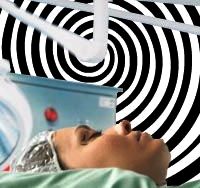Just imagine: you have a banal acute appendicitis. Procedure of the operation that will save you life studied by medicine thoroughly. However, there is an absolute contraindication: individual intolerance of anesthetics. Output exists. This is hypnosis.
Content
Only one group of Belgian doctors led by Mary-Elizabeth Feymonville has already spent more than five thousand operations under hypnosis. In the method developed by Dr. Feymonville, the general anesthesia is replaced by a combination of hypnosis, local anasthesthesia and a moderately active sedative. «Patients remain very pleased, - says the team leader. - Such a sparing approach constantly attracts a lot of patients from all five continents».
Advantages of hypnosis before anesthetics
 For the first time, hypnosis was used as a surgical anesthetic agent in India in 1845. But after a year, the ether appeared in medical practice, and this innovation has long supposed hypnosis from the Arsenal surgeons, turning it into a funny trick for secular living rooms. In 1958, the use of hypnosis in medicine was officially authorized by the American Medical Association. Since then, doctors in the new light hypnotized patients in order to facilitate their condition with diseases such as migraine, depression, increased anxiety and chronic cancer pain.
For the first time, hypnosis was used as a surgical anesthetic agent in India in 1845. But after a year, the ether appeared in medical practice, and this innovation has long supposed hypnosis from the Arsenal surgeons, turning it into a funny trick for secular living rooms. In 1958, the use of hypnosis in medicine was officially authorized by the American Medical Association. Since then, doctors in the new light hypnotized patients in order to facilitate their condition with diseases such as migraine, depression, increased anxiety and chronic cancer pain.
In surgery, hypnosis used mainly in Europe. And most often in order to avoid affected effects caused by anesthesia. Thus, the well-mentioned Belgian group of doctors showed that with the use of hypnosis, patients need less than one percent of drugs appointed with general anesthesia. It is possible to get rid of such unpleasant consequences as nausea, increased weakness, coordination violation and reduction of mental abilities. So, according to Feimonville, patients with thyroid diseases, which were operated on under hypnosis, returned to work almost twice as fast as the same patients who have undergone a total anesthesia.
Hypnosis instead of anesthesia: successful experience
Meanwhile, research using the most advanced technical means shed a new light on how hypnosis works and how it blocks pain. In particular, at the University of Iowa, healthy volunteers measured the perception of pain under hypnosis and without it. At the same time, the participants in the experiment assessed their feelings on a 10-point scale. As a result, it turned out that the hypnotherapist was able to reduce the intensity of pain with eight points to three and below. And some hypnotized subjects did not feel any pain at all.
Scanning brain volunteers showed significant differences in the passage of pain. In hypnotized participants of the experiment, these signals followed the usual path from the brain barrel to the middle brain, but did not reach the bark, where the conscious feeling of pain arises.
Received new data contributed to the emergence of another wave of interest in hypnosis in the United States. In a number of US hospitals, it began to apply for those patients who have allergies to anesthetics. At the Department of Psychiatry and Behavioral Sciences of Stanford University of People suffering from Parkinson's disease, hypnotize for the time of implantation of the electrodes in the deep brain departments. Without hypnosis, this operation is very difficult to the tremor - trembling, which such patients are subjected to, the general anesthesia cannot be done, because during the procedure they should remain conscious.
There, in Stanford University, hypnosis is successfully used in the treatment of children. Little patients inspire that with the help of a balloon attached to hand, they fly away to their favorite places and thus calm them for the time of the unpleasant cloud catheterization procedure.
In the clinic of the University of Iowa hypnotize patients to reduce pain and concern during preoperative anesthesia of the nerve spinal cord roots. In this case, the anesthetic effect of hypnosis is often lasting throughout the operation.
And yet, despite the listed successes, even the most enthusiastic supporters of anesthesia with hypnosis do not suggest that it is completely replaced by traditional anesthesia. On the one hand, not every person you can hypnotize. Only 15 percent of patients with hypnosis is completely percentage, 60 - can only be introduced into the trance, and the rest do not react at all at all.
On the other hand, many patients prefer common anesthesia because they do not want to hear anything or feel before surgery. Well, the desire of the patient, of course, if they do not contradict the main tactics of treatment, should respect.









